
Figure 1. Lightbox images showing silvery-thread moss gametophyte injury at 14 days after treatment from an application of carfentrazone-ethyl. The six small, circular green patches are creeping bentgrass plugs. Doses, expressed in fluid ounces per acre, are shown in bottom-left corners of images. The label rate for silvery-thread moss control in creeping bentgrass putting greens is 6.7 fluid ounces per acre.
Silvery-thread moss (STM) is a problematic perennial weed in putting greens because it possesses several weedy attributes, and control options are limited. Populations of STM growing in putting greens have a faster growth rate and three- to four-fold increase in shoot density compared to off-green populations (4). The specialized populations of STM growing in putting greens can invade in a single growing season and become increasingly difficult to control as the age and size of the infestation increases (Z. Raudenbush, personal communication). Quicksilver (active ingredient carfentrazone-ethyl, FMC) is commonly used to control STM in golf course putting greens in the United States. Carfentrazone-ethyl is a contact herbicide capable of showing herbicidal symptoms two hours after treatment (5).
Quicksilver has a supplemental label for STM control in creeping bentgrass putting greens. The label stipulates two STM control strategies: 1) burndown and control of STM in bentgrass greens and tees, apply 6.7 fluid ounces per acre (490 milliliters per hectare), followed by a second application two weeks later at the same rate; 2) control over longer periods, applications may be repeated every two weeks at a rate not less than 2.0 fluid ounces per acre (146 milliliters per hectare) (1). Regardless of application strategy, no more than 27 fluid ounces per acre (1.97 liters per hectare) can be applied per year. Several researchers have evaluated the efficacy of carfentrazone-ethyl when applied at 6.7 fluid ounces per acre (2, 3, 6); however, minimal research has evaluated lower use rates. Kennelly et al. compared carfentrazone-ethyl applied at 3.3 and 6.7 fluid ounces per acre (241 and 490 milliliters per hectare) to creeping bentgrass and reported no differences in STM control between the two rates throughout the study (3).
The possibility of controlling STM with lower carfentrazone-ethyl rates would be valuable to superintendents from both environmental and fiscal standpoints. Therefore, the objective of this research was to determine the efficacy of a single postemergence (POST) application of carfentrazone-ethyl for STM control at rates ranging from 1⁄8X to 2X (where X = the approximate label rate of 6.7 fluid ounces per acre).
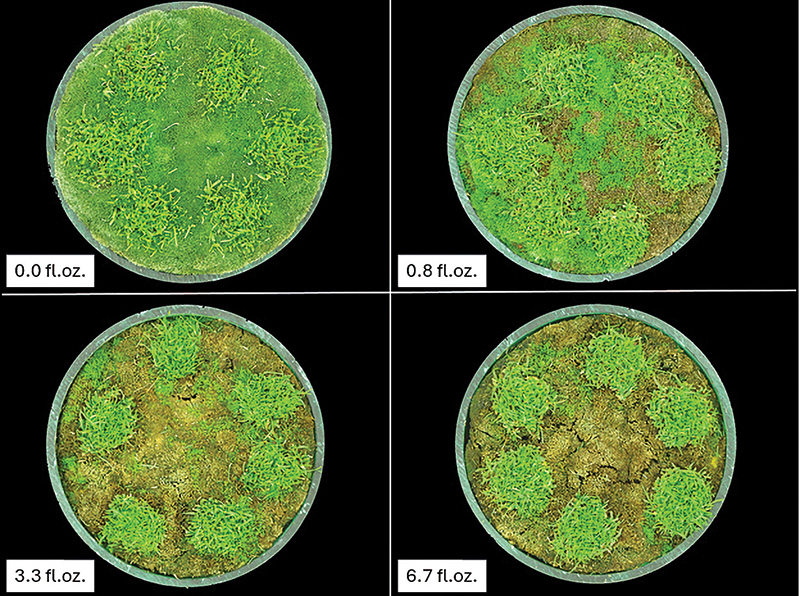
Figure 2. Lightbox images showing silvery-thread moss gametophyte injury at 49 days after treatment from an application of carfentrazone-ethyl. Doses, expressed in fluid ounces per acre, are shown in bottom-left corners of images. The label rate for silvery-thread moss control in creeping bentgrass putting greens is 6.7 fluid ounces per acre.
Materials and methods
Initial dose assessment
Growth chamber studies were conducted to determine the carfentrazone-ethyl dose response in managing STM. The STM population used in this study was collected from a research putting green at Rocky Ford Turfgrass Research Center (Manhattan, Kan.). The population was established in the greenhouse for three months, and dried plant material was shredded in a coffee grinder to use for planting.
Polyvinyl chloride (PVC) containers (4-by-9-inches deep/10.16-by-22.86-centimeters deep) were filled with 1.5 inches (3.81 centimeters) of pea gravel, and then filled with 7 inches (17.78 centimeters) of moist sand, following the USGA recommendations for a putting green root zone. Containers (hereafter referred to as “pots”) were planted with 1.2 grams of ground STM and immediately irrigated with 0.2 inches (0.5 centimeters) of water using a misting nozzle. Pots were then placed in the growth chamber set to a day/night temperature of 68/62.6 F (20/17 C) and a 16-hour photoperiod. Each pot was irrigated daily with 0.1 inches (0.25 centimeters) of water and fertilized weekly with a Hoagland 1:10 solution.
To prevent STM from curling at the pot edge, six 0.5-inch diameter × 3.0-inch (1.27 × 7.62-centimeter) creeping bentgrass cv. 007 plugs were inserted through established STM and into the sand substrate (Figure 1). The plugs were trimmed at 0.15 inches (0.38 centimeters) with scissors throughout the duration of the study. All pots had 100% cover and an average shoot length of 0.5 inch at 90 days after planting.
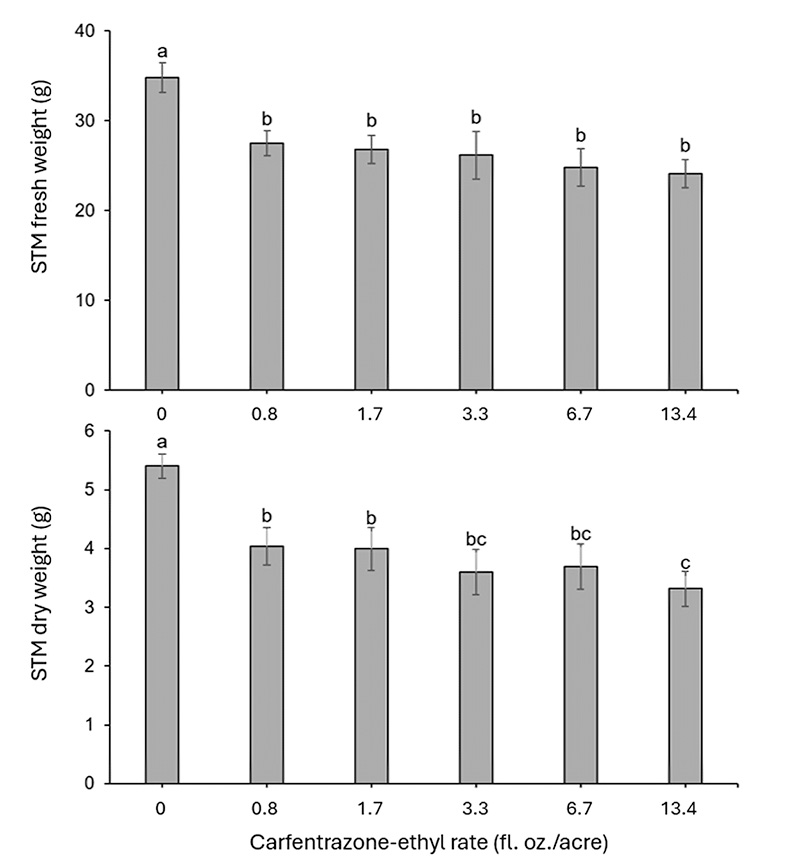
Figure 3. Effect of carfentrazone-ethyl on silvery-thread moss gametophyte fresh- and dry-weight harvested at 77 days after treatment. Bars indicate standard error and treatments with the same letter above the bar are not significantly different (P < 0.05) according to Fisher’s protected LSD test.
Carfentrazone-ethyl was applied at six rates (0, 0.8, 1.7, 3.3, 6.7 and 13.4 fluid ounces per acre/0, 58, 124, 241, 490 and 979 milliliters per hectare) using a XR8002EVS nozzle at 25 gallons per acre (234 liters per hectare) and included a nonionic surfactant at 0.25% v/v. Pots were evaluated for STM injury weekly for 11 weeks using a scale of 0%-100%. At 77 days after treatment (DAT), STM was harvested, and fresh and dry weight was recorded.
Shoot viability following herbicide treatment was also determined by harvesting individual shoots directly from the pots described above. At 3 DAT, eight random shoots were harvested from the pots and planted into petri dishes containing sterilized sand root zone. We determined the viability of individual shoots at seven and 14 days after plating (DAP) by counting the number of shoots with >5 leaves.
Percent STM injury, STM fresh and dry weight, and shoot viability counts were analyzed using SAS.
Field studies
Field studies were conducted from June to August in 2015 in Kansas and California. The sites utilized sand-based root zones containing Penncross and L-93 creeping bentgrass, respectively, and were mowed, irrigated and fertilized to maintain acceptable putting green quality.
Both sites had existing STM infestations; however, the number of plots were limited so carfentrazone-ethyl treatments were reduced to evaluate five rates (0, 1.7, 3.3, 6.7 and 13.4 fluid ounces per acre). Treatments were applied using a single-nozzle XR8004EVS with a spray volume of 1 gallon per 1,000 square feet (407 liters per hectare). Percent STM control was calculated by comparing grid counts from plots treated with carfentrazone-ethyl to the nontreated plot.
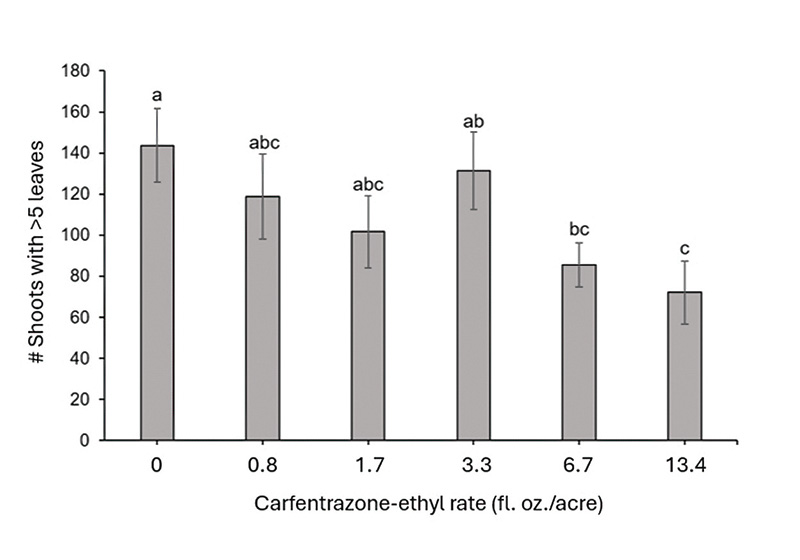
Figure 4. Viability of eight plated silvery-thread moss shoots 17 days after being harvested from pots treated with differing rates of carfentrazone-ethyl. Bars indicate standard error and treatments with the same letter above the bar are not significantly different (P < 0.05) according to Fisher’s protected LSD test.
Results and discussion
Growth chamber: Initial dose assessment
In the growth chamber, significant STM injury (>85%) was observed at 14 DAT for all rates (Figure 1). Recovery was not observed until >21 DAT, and by 49 DAT, the lowest rate of 0.8 fluid ounces per acre STM recovered to reduce injury to 50%, whereas rates of 1.7-13.4 fluid ounces per acre continued to show >85% injury (Figure 2). These results suggest carfentrazone-ethyl applied every 14 days may utilize the lowest labeled rate of 2.0 fluid ounces per acre, whereas the higher rate (6.7 fluid ounces per acre) may allow for longer reapplication intervals.
Silvery-thread moss weight was also affected by carfentrazone-ethyl dose in growth chamber studies. Non-treated STM had higher fresh and dry weight compared to those treated with carfentrazone-ethyl (Figure 3). There were no differences in weights of STM among carfentrazone-ethyl doses tested (Figure 3); while several doses caused >85% visual injury, that was not accompanied by proportionate decreases in fresh and dry weight. This result demonstrates an ability of STM to resist decay after being injured by carfentrazone-ethyl.
Carfentrazone-ethyl also affected the viability of individual shoots (Figure 4). At 7 DAP (corresponding to 10 DAT), petri dishes containing shoots harvested from non-treated STM had a mean count of 7.8 shoots with >5 leaves, while shoots harvested from STM receiving any carfentrazone-ethyl dose had none (data not shown). The shoots in non-treated pots at 7 DAP were not new growth, rather the existing STM shoot tip (Figure 5). Furthermore, while no carfentrazone-ethyl-treated STM had shoots with >5 leaves at 7 DAP, nearly all the collected shoots (from all carfentrazone-ethyl doses) were producing new leaf growth (Figure 5b).
Eight individual shoots produced >60 new plants at the highest dose in our study (Figure 4), which reinforces the importance of taking action in the early stages of an STM infestation, since a small colony can contain thousands of individual shoots.
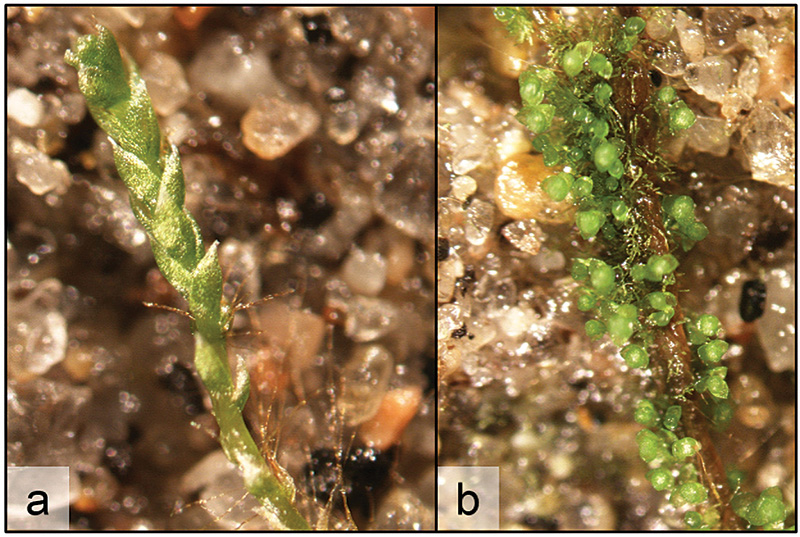
Figure 5. Silvery-thread moss (STM) shoots collected from carfentrazone-treated STM in a growth chamber: a) untreated shoot; b) shoot from STM treated with carfentrazone-ethyl at 3.3 fluid ounces per acre.
Dose responses in the field
Quicksilver controlled STM in the field study but greater STM control was achieved in California compared to Kansas at two and four weeks after treatment (WAT) (data not shown). We averaged data across locations at 2 WAT, which provided 76% and 84% STM control at 3.3 and 6.7 fluid ounces per acre, respectively. These results were greater than the 52% injury caused by 1.7 fluid ounces per acre (Table 1). By 4 WAT, STM recovery was observed, and control was reduced to 45% and 48% when treated at 3.3 and 6.7 fluid ounces per acre, respectively. By 6 WAT, a majority of the STM recovered, and relative percent control ranged from 25% to 59%. Ultimately, an application of carfentrazone-ethyl is highly effective at injuring STM, but the effects are temporary, and regrowth can occur.
Carfentrazone-ethyl is an extremely valuable tool for reducing the performance of STM; however, the ability of this plant to resist decay is perhaps its best weedy attribute. Future research to determine practices that encourage the breakdown and decomposition of treated STM would be valuable. Our research supports incorporating the strategic use of carfentrazone-ethyl when attempting to manage an STM infestation; however, superintendents who rely solely on applications of carfentrazone-ethyl to eliminate this pest may find their efforts to be unsuccessful.
The research says
- Carfentrazone-ethyl is an extremely valuable tool for reducing the performance of STM; however, the ability of this plant to resist decay is perhaps its best weedy attribute.
- Future research to determine practices that encourage the breakdown and decomposition of treated STM would be valuable.
- Our research supports incorporating the strategic use of carfentrazone-ethyl when attempting to manage an STM infestation; however, superintendents who rely solely on applications of carfentrazone-ethyl to eliminate this pest may find their efforts to be unsuccessful.
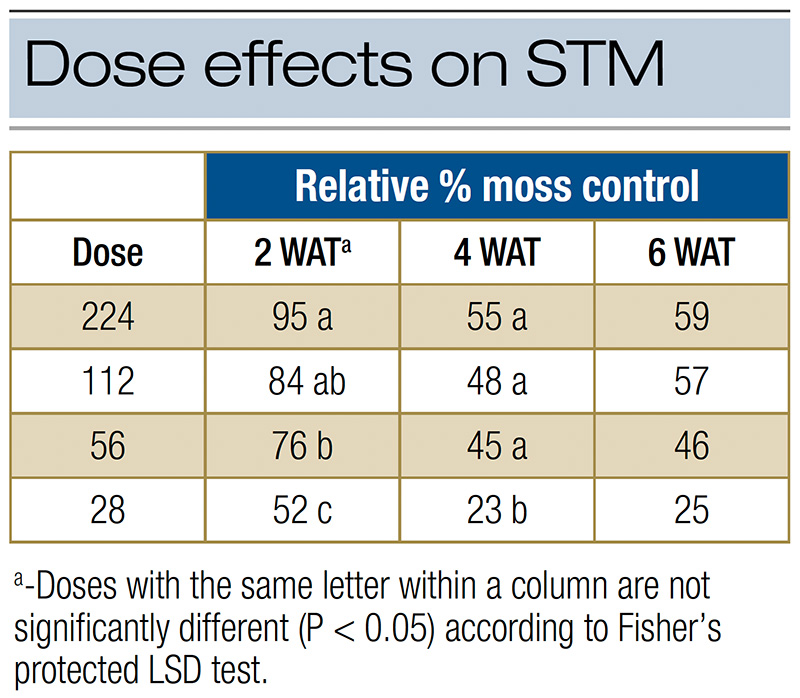
Table 1. Main effect of carfentrazone-ethyl dose (28, 56, 112, 224 grams active ingredient per hectare) on relative percent silvery-thread moss control at two, four and six weeks after treatment (WAT) averaged across locations in Manhattan, Kan., and San Luis Obispo, Calif. Note: 112 grams a.i. per hectare is the highest label rate for silvery-thread moss control in creeping bentgrass putting greens.
Acknowledgements
Authors thank the Kansas Turfgrass Foundation for funding this research. No conflicts of interest have been declared.
Literature cited
- Anonymous. 2015. Quicksilver T & O herbicide moss control supplemental label: 10/06-C. FMC Corporation Agricultural Products Group, Philadelphia, Pa.: FMC. 4 p.
- Borst, S.M., J.S. McElroy and G.K. Breeden. 2010. Silvery-thread moss control in creeping bentgrass putting greens with mancozeb plus copper hydroxide and carfentrazone applied in conjunction with cultural practices. HortTechnology 20(3):574-578 (https://doi.org/10.21273/HORTTECH.20.3.574).
- Kennelly, M.M., T.C. Todd, D.M. Settle and J.D. Fry. 2010. Moss control on creeping bentgrass greens with standard and alternative approaches. HortScience 45(4):654-659 (https://doi.org/10.21273/HORTSCI.45.4.654).
- Raudenbush, Z., J.K. Greenwood, D.N. McLetchie, S.M. Eppley, S.J. Keely, R.C. Castetter and L.R. Stark. 2018. Divergence in life-history and development traits in silvery-thread moss (Bryum argenteum Hedw.) genotypes between golf course putting greens and native habitats. Weed Science 66(5):642-650 (https://doi.org/10.1017/wsc.2018.37).
- Thompson, W.M., and S.J. Nissen. 2000. Absorption and fate of carfentrazone-ethyl in Zea mays, Glycine max and Abutilon theophrasti. Weed Science 48(1):15-19 (https://doi.org/10.1614/0043-1745(2000)048[0015:AAFOCE]2.0.CO;2).
- Thompson, C., J. Fry and M. Kennelly. 2011. Evaluation of conventional and alternative products for silvery-thread moss control in creeping bentgrass. Applied Turfgrass Science 8(1):1-9 (https://doi.org/10.1094/ATS-2011-1018-01-RS).
Zane Raudenbush is a turfgrass and herbicide specialist for The Davey Tree Expert Company, Kent, Ohio; Steven J. Keeley is a professor at Kansas State University, Manhattan; Cole Thompson is director of Turfgrass and Environmental Research, USGA, Liberty Corner, N.J.; and Mithila Jugulam is a professor at Kansas State University, Manhattan.